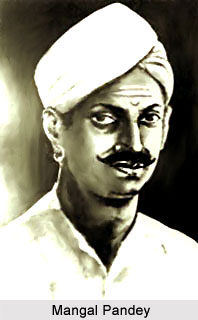 Mangal Pandey was considered as the chief initiator and the centre stage in the Barrackpore (Barrackpur) uproar. The British had three musketry depots, in Dum Dum, Ambala and Sialkot and three arsenals in Fort William, Calcutta, Dum Dum and Meerut. The Brown Bess muskets the sepoys owned were going to be replaced by the Enfield rifle in which a new kind of greased bullet was to be used. The tallow used in grease had to be extracted from an animal and sepoy regiments were ordered to send detachments to the various musketry depots (bullets were manufactured in the arsenals).This led to an unrest among the sepoys. British officers did not take the Barrackpore insurgency warning seriously. Soon fires appeared in Barrackpore as well. Bungalows were set ablaze and the telegraph office was attacked. These fires were the work of urban labourers brought over from Calcutta. The men then joined ranks with the Barrackpore bazaar elements. The intended effect was to alarm the sepoys, to create an atmosphere of dread and defiance.
Mangal Pandey was considered as the chief initiator and the centre stage in the Barrackpore (Barrackpur) uproar. The British had three musketry depots, in Dum Dum, Ambala and Sialkot and three arsenals in Fort William, Calcutta, Dum Dum and Meerut. The Brown Bess muskets the sepoys owned were going to be replaced by the Enfield rifle in which a new kind of greased bullet was to be used. The tallow used in grease had to be extracted from an animal and sepoy regiments were ordered to send detachments to the various musketry depots (bullets were manufactured in the arsenals).This led to an unrest among the sepoys. British officers did not take the Barrackpore insurgency warning seriously. Soon fires appeared in Barrackpore as well. Bungalows were set ablaze and the telegraph office was attacked. These fires were the work of urban labourers brought over from Calcutta. The men then joined ranks with the Barrackpore bazaar elements. The intended effect was to alarm the sepoys, to create an atmosphere of dread and defiance.
Consequences of the Incident
Sepoys (soldiers) were alarmingly unresponsive to finding out the reason behind the fires. No one was ever caught and the sepoy (soldier) parties sent to hunt down the suspects.
In Lucknow, Mangal Pandey had witnessed a British subaltern disgracing an Awadhian noble woman and he had stepped in to stop the abuse. He desired punishment for the subaltern, but white officers were stern and asked him not to interfere.
Hearsey, a British officer clearly expected something dramatic to happen. On 11th February, gunpowder and practice cartridges reached Behrampore. The die was now cast. The sepoy would have to make the fatal decision of whether to break their caste or revolt.
Mangal had sent Nakki to Behrampore who later sent Bechan ahead. Bechan delivered a message to the 19th men that the 2nd were ready to mutiny and would the 19th men join them in their endeavour. The 19th men did not approval for an all out revolt, arguing first for petitioning Hearsey. More radical elements were hushed up. A midway compromise was reached and Mangal gave his approval.

In another incident, Behrampore sepoys (soldiers) refused to take the caps on a parade on 26th February. It was the custom to distribute percussion caps before a parade. This was a clear statement as of yet of the soldiers showing open defiance.
In what seems like a historic turning point, a panchayat was called. Placing the religious scriptures forward, the ringleaders made Hindu and Muslim soldiers swear not to take the cartridges. The level of coordination and unity was incredible. From the beginning, sepoys were inspired by the idea of initiating a civil rebellion. Mitchell, himself a `new` officer, threatened to take action. He told native officers that sepoys refusing to take the cartridge would be packed off to Burma and China. The issue of travelling by sea and crossing the `black waters` (refers to the Indian Ocean, which was inaccessible to natives during those periods) had ignited the 1824-25 Bengal mutinies.
 On 26th February, the sepoys had broken the bell of arms and taken their weapons. There was also a roll of drums (meant to imply the gathering of sepoys). Mitchell acted quickly by summoning the cavalry and the artillery. Later a compromise was reached. Mitchell agreed to withdraw the cavalry and the artillery, the conditions placed by sepoys before giving up their arms. For the whole of February and March, Behrampore sepoys were not punished. They had committed a mutinous act but again, bargain avoided bloodshed.
On 26th February, the sepoys had broken the bell of arms and taken their weapons. There was also a roll of drums (meant to imply the gathering of sepoys). Mitchell acted quickly by summoning the cavalry and the artillery. Later a compromise was reached. Mitchell agreed to withdraw the cavalry and the artillery, the conditions placed by sepoys before giving up their arms. For the whole of February and March, Behrampore sepoys were not punished. They had committed a mutinous act but again, bargain avoided bloodshed.
Mangal Pandey and Nakki Khan considered the Behrampore incident both as a victory and a partial set back. They had expected the British to be far more severe
Sepoys were watching every British move, even the expressions of the British. The distance was too great, even though Lord Canning hoped for the best while agreeing that the cartridge controversy "turned out to be well founded".




















